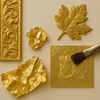The Golden Touch: Gold Leaf in Monumental Masonry Restoration
- by Sam Wozniak
In the world of monumental masonry, the use of gold leaf is both an art and a science. Whether adorning gravestones, memorial plaques, church facades, war memorials, or civic stonework, gold leaf transforms austere stone into something transcendent. At Wrights of Lymm, with nearly two centuries of experience in gilding and restoration, we believe that informed application is the key to longevity, durability, and visual impact.
This post will examine how goldleaf is used in monumental masonry, guide you through techniques, discuss challenges of restoration, and explain why Wrights of Lymm is uniquely placed to support monumental masons, conservators, and memorialists.
Why Use Gold Leaf in Monumental Masonry?
Gold’s inherent qualities make it a superb choice for monumental work:
-
Durability: Properly applied gold leaf resists tarnishing and weathers with dignity.
-
Legibility: Inscribed text (names, dates, dedications) gilded in gold remains readable over many decades, even as stone weathers.
-
Aesthetic prestige: Gold carries symbolic weight in memorials, heritage sites, and ecclesiastical architecture.
-
Cultural continuity: Many historic monuments originally used gilding; restoration or new commissions benefit from that continuity.
For inscriptions especially, many monument firms prefer 23.5ct gold leaf (or nearby alloys) for its balance of durability and colour tone.
A high-profile example: in the Washington Monument, carved stone tablets with incised gilding were conserved and regilded using gold leaf, matching original alloys and respecting reversibility constraints.
Key Challenges in Monumental Gilding
Using gold leaf on stone presents special complications:
-
Surface porosity and texture
Stone—especially granite, marble, limestone, or sandstone—varies in absorbency and micro texture. If the surface isn’t properly sealed and primed, adhesive or size can sink in unevenly, causing poor adhesion or patchy gilding. We recommend the use of a Transparent Sealer before gilding.
-
Weather exposure & durability
Monuments are exposed to cycles of moisture, frost, pollution, UV and biological growth (moss, lichens). The chosen gilding system must resist flaking, lifting, or loss of adhesion as the underlying stone moves. -
Matching historical material
In restoration, existing gilding may use older alloys or adhesives. Achieving colour match (tone, reflectivity) while ensuring modern durability demands careful material selection. -
Reversibility and conservation ethics
Where heritage conservation is concerned, interventions must often be reversible or at least benign to the original substrate. Overzealous mechanical cleaning or grinding can damage inscriptions or stone faces. -
Scale and access
Large memorials or facades introduce logistics of scaffolding, environmental control during application (wind, dust), and safety.
Given these challenges, a rigorous method is essential when gilding monument masonry.
Gilding Techniques for Monumental Work
Two main gilding routes are most relevant to monumental masonry: oil/organic adhesive (mordant) gilding and modified exterior gilding systems. (Traditional water gilding, though capable of high polish, is rarely suitable for exterior monumental stone.)
Oil Adhesive Gilding
This is the time-tested approach for exterior surfaces:
-
Surface preparation
Clean stone of dirt, salts, biological growth, and any friable material. Repair micro cracks or spalls. Let the substrate dry fully. -
Sealing / priming
Apply a primer or Transparent Sealer layer (a tinted, penetrating sealer) to help smooth and control surface absorbency. -
Size application
An oil-based size (adhesive) is brushed or rolled on. It must be uniformly applied without pooling in recesses. The optimal moment is when the size is tacky to the touch—but not wet. If gold is applied too early, it may “flood” (lose its lustre), if too late it won’t adhere. -
Gold leaf application
Sheets of gold (often 24ct, 23.75ct or 23.5ct for exterior work) are laid onto the tacky adhesive using soft gilding brushes or tips, gently pressed down, and excess fragments (skewings) brushed off. -
Burnishing / finishing
Depending on desired reflectivity, a soft brush may be used; burnishment with agate stone is generally minimal in exterior work to avoid abrasion.
In some projects, a final protective clear lacquer or coating is sometimes added for extra weather resistance (though coatings must be selected carefully for breathability and reversibility).
This method yields excellent durability under proper execution.
Modified or Acrylic-Based Exterior Gilding
Modern conservation and architectural work sometimes employs acrylic or polymer-modified gilding systems. These use modern synthetic adhesives or fixatives with UV and moisture resistance, sometimes in combination with micro-abrasion or consolidation layers. The goal is to retain visual fidelity while boosting lifespan and structural resilience.
In restoration of the Washington Monument, for example, an exterior acrylic gilding system was selected to balance durability and reversibility.
When working with polymer systems, one must ensure the adhesive is compatible with the stone and does not produce long-term staining, embrittlement, or peeling. Always test in inconspicuous areas.
Step-by-Step Workflow for Monumental Gilding
The following outlines a robust workflow when using gold leaf on monumental masonry:
1. Condition Survey & Assessment
-
Map existing inscription surfaces, note areas of damage, flaking, or biological growth.
-
Analyse any existing gilding residues (microsampling) to identify alloy, adhesive, and layer structure.
-
Test stone absorption, surface strength, and moisture behaviour.
2. Cleaning and Preparation
-
Use gentle, non-aggressive cleaning (mild detergents, poultices, micro-abrasion, controlled steam)
-
Stabilize friable stone, fill cracks or defects with compatible mortar or grout
-
Allow thoroughly dry (monitor moisture content)
3. Primer / Sealer Application
-
Apply a burnish sealer or tinted primer to smooth textural variation
-
Dry and inspect for pinholes or absorption anomalies
-
Touch up where needed
4. Size Application
-
Use a consistent coat of oil (or compatible) size
-
Monitor tack development (test with small scrap)
-
Correct any pooling or heavy areas, especially in recesses
5. Leaf Application
-
Work in manageable segments (not the entire inscription at once)
-
Use soft tipped brushes or gilders’ tips to lay gold leaf
-
Gently press and burnish (if required)
-
Remove skewings and fine debris
6. Protection and Finishing
-
Optional: apply a thin clear protective lacquer or micro-coating, if well judged
-
Inspect for adhesion failures or pinholes
-
Document progress and coatings used
7. Maintenance and Monitoring
-
Perform periodic inspections (e.g. annually)
-
Keep surfaces free from grime, biological growth, pollutants
-
Touch-up small losses with matching leaf
-
Record interventions for future conservators
Restoration: Re-Gilding Historic Monuments
Restoration of existing monuments often involves re-gilding worn inscriptions or decorative elements. Key considerations include:
-
Respecting the original colour and alloy
-
Minimising removal of surviving historic gold or adhesive
-
Ensuring reversibility (or at least non-destructive interventions)
-
Matching the reflectivity, tone, and texture of the existing gilding
-
Addressing substrate deterioration (moisture, salts, freeze-thaw cycles)
In many instances, previous re-gilding attempts have used less appropriate materials that trap moisture or deteriorate faster. A modern, well-engineered gilding approach can significantly extend the next service interval.
For example, the Washington Monument tablets were carefully isolated, existing gilding consolidated, then new leaf was applied using acrylic exterior systems to limit damage to original layers.
Why Wrights of Lymm Is the Right Partner
Wrights of Lymm, established in 1840 and now a Royal Warrant holder, is one of the UK’s oldest gold leaf manufacturers and suppliers.
We offer several advantages to monumental masons, conservators, and memorial firms:
-
Full range of gold leaf alloys (24 ct down to 6 ct) — ideal for matching historic specification or budget constraints.
-
Technical guidance & support — our in-house team offers advice on gilding systems, substrate compatibility, mock-ups, and conservation best practice.
-
Reliable supply — with next-day delivery in many cases, backed by solid stock holdings.
-
Trustworthy heritage credentials — we’ve served palaces, cathedrals, restoration projects, and long-standing clients through multiple generations.
When you source gold leaf from Wrights of Lymm, you benefit not only from premium materials, but decades of accumulated expertise in gilding and restoration.
Best Practices & Tips for Monumental Gilding
-
Always trial a small hidden section before committing to full inscription gilding.
-
Avoid applying leaf onto a wet or overly glossy surface — the adhesion will suffer.
-
If applying protective coatings, choose ones that are breathable and do not yellow or embrittle.
-
Record in writing all materials, adhesives, thicknesses, mock-ups, and coverage details for future conservation.
-
Budget for periodic maintenance — even well-applied gold leaf is not entirely self-sustaining in the harshest exposures.
-
Consider micro-texturing or microscopic anchoring (e.g. slight roughening) of the stone before sizing in extreme climates.
Conclusion
Gold leaf in monumental masonry is far more than ornament — it is a means of preserving memory, elevating text, and linking modern restoration to centuries of tradition. Done well, gilding transforms stone into a radiant, reverent focal point. Done poorly, it fails early and damages substrate.
At Wrights of Lymm, we bring not just materials but deep craftsmanship heritage, technical support, and rigorous standards. Whether for new memorial commissions or restoration of historic monuments, we are ready to assist you with the right gold leaf, system advice, and supply reliability.
Reach out to us for a consultation, and let your next monumental gilding commission reflect both prestige and permanence.






